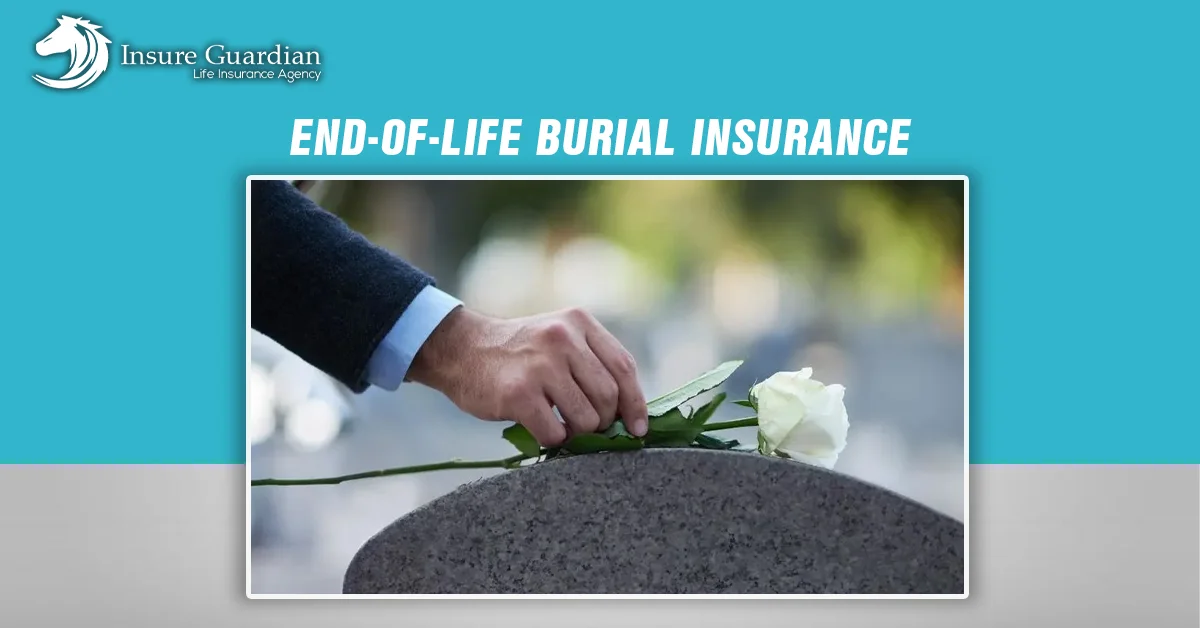In life’s quiet moments, there’s a whisper of reassurance; end-of-life burial insurance. It’s the quilt of comfort that wraps around your dear ones, ensuring their focus remains on bidding farewell, not on financial burdens. This isn’t just a policy; it’s a heartfelt promise to pave the path ahead without the weight of funeral expenses or lingering bills.
Our guide is a compass through the landscape of end of life burial insurance. From unraveling its essence to uncovering the subtle contrasts between term and whole life plans, we’ll journey through this vital financial safety net. Together, we’ll navigate the maze of health considerations, explore the world of policy riders, and ponder the coverages offered by standard life insurance for those end-of-life expenses.
Join us as we embrace this thoughtful shield, providing serenity to both you and your treasured ones as you script the final chapters of life.
What is the end-of-life insurance coverage?
End-of-life insurance coverage typically refers to life insurance policies that provide financial protection and benefits to the policyholder’s beneficiaries upon the death of the insured. These policies are designed to help cover end-of-life expenses, such as, outstanding debts, and other financial obligations that may arise after the policyholder’s death.
The benefits of end-of-life insurance coverage include providing financial security for loved ones, ensuring that final expenses are taken care of, and potentially leaving a legacy for beneficiaries. It’s important to carefully consider your needs and the type of coverage that best fits your situation when choosing an end-of-life insurance policy.
What is the best end-of-life insurance?
The best end-of-life insurance policy depends on individual circumstances, including financial needs, health status, and personal preferences. Here are some common types of end-of-life insurance policies to consider:
- Term Life Insurance: Provides coverage for a specific period (e.g., 10, 20, or 30 years). It’s typically more affordable than whole life insurance but does not build cash value.
- Whole Life Insurance: Offers coverage for your entire life and includes a cash value component that grows over time. Premiums are generally higher than term life insurance but provide lifelong coverage and a savings component.
- Final Expense Insurance: A type of whole-life insurance designed to cover end-of-life expenses, such as funeral and burial costs, medical bills, and outstanding debts. It usually has lower coverage amounts and premiums compared to traditional whole-life insurance.
- Guaranteed Issue Life Insurance: A type of whole life insurance that does not require a medical exam or health questionnaire. It’s typically more expensive and offers lower coverage amounts, making it suitable for individuals who may have difficulty qualifying for other types of life insurance.
What is End-of-Life Burial Insurance?
End of life burial insurance, also known as final expense insurance, is a specialized type of life insurance policy designed to cover the costs associated with a person’s funeral, burial, and other end-of-life expenses. Unlike traditional life insurance policies that offer larger payouts for various purposes, end of life burial insurance specifically focuses on providing financial support to cover the expenses related to the policyholder’s death.
These policies typically offer a smaller death benefit, usually ranging from $5,000 to $25,000, which is intended to cover funeral and burial costs, as well as other final expenses, such as medical bills or outstanding debts. The primary aim of this insurance is to alleviate the financial burden on family members or beneficiaries during a challenging and emotional time, ensuring that they are not burdened with the expenses related to the policyholder’s passing.
Pros and Cons of End-of-Life Burial Insurance
End of life burial insurance, while serving as a valuable financial safety net, comes with its own set of advantages and considerations. Understanding the pros and cons can help individuals make informed decisions regarding this type of insurance:
Pros
- Affordability: Premiums for end of life burial insurance are often more affordable compared to traditional life insurance policies, making them accessible to individuals on fixed incomes or with limited budgets.
- Ease of Qualification: Many of these policies do not require extensive medical exams, allowing individuals with health issues or pre-existing conditions to secure coverage more easily.
- Dedicated Expense Coverage: The policy’s primary focus is on covering funeral and burial expenses, ensuring that these costs are taken care of and relieving loved ones of the financial burden.
- Quick Payouts: Claims for end of life burial insurance policies are usually processed quickly, providing beneficiaries with the necessary funds promptly after the policyholder’s passing.
Cons
- Limited Coverage Amount: The death benefit for end-of-life burial insurance tends to be smaller, often ranging from $5,000 to $25,000. This might not cover other substantial financial needs or debts beyond funeral expenses.
- Potential Premium Increases: Some policies may have increasing premiums as the policyholder ages, potentially making them more expensive over time.
- Waiting Periods: Certain policies might have a waiting period before the full death benefit is available. If the policyholder passes away during this period, the benefit paid out might be limited.
- Coverage Restrictions: Depending on the insurance company and policy, there might be restrictions or limitations on coverage for certain health conditions or circumstances, impacting the policy’s effectiveness.
Comparing End of Life Burial Insurance Plans: Term vs. Whole Life
When exploring end of life burial insurance, two primary policy types often emerge: term life and whole life insurance. Here’s a comparison between these two options:
Term Life Insurance
Coverage Period: Term life insurance provides coverage for a specified period, such as 10, 15, or 20 years.
Premiums: Typically, premiums are lower compared to whole life insurance for the same coverage amount during the term.
Expiration: Once the term ends, coverage expires unless the policy is renewed. Renewing might come with increased premiums based on the policyholder’s age and health.
Flexibility: It’s straightforward and offers coverage for a specific duration, making it suitable for those seeking temporary financial protection.
Whole Life Insurance
Lifetime Coverage: Whole life insurance provides coverage for the entire life of the policyholder as long as premiums are paid.
Premiums: Generally, premiums are higher but remain consistent throughout the policy’s duration, and the policy accrued cash value over time.
Cash Value: These policies have a savings component that accumulates cash value, which can be accessed through loans or withdrawals during the policyholder’s lifetime.
Stability: It offers stability with fixed premiums and a lifelong death benefit, making it a long-term financial investment.
Considerations
Budget and Longevity: Term life insurance suits those on a tight budget or needing coverage for a specific period, while whole life insurance caters to those seeking lifelong coverage and cash value accumulation.
Purpose: Choosing between term and whole life depends on the intended use of the policy, whether it’s solely for end of life expenses or as a long-term financial tool.
Moreover, deciding between term and whole life insurance for end of life burial purposes involves understanding individual financial needs, considering budget constraints, and evaluating preferences for coverage duration and financial planning.

What is the Role of Health Conditions in End-of-Life Burial Insurance?
Health conditions play a significant role in determining eligibility, premiums, and coverage limitations when it comes to end of life burial insurance. Here’s a closer look at their impact:
Eligibility and Approval
- Medical Underwriting: While some end of life burial insurance policies do not require a medical exam, they may still ask health-related questions during the application process. Applicants must provide accurate information about their health status.
- Acceptance with Health Conditions: These policies are often more lenient compared to traditional life insurance, allowing individuals with certain health issues or pre-existing conditions to obtain coverage more easily.
Premiums and Coverage
- Health Influence on Premiums: Health conditions can affect the cost of premiums. Those with higher health risks or severe medical conditions may face increased premiums compared to healthier individuals.
- Coverage Limitations: Certain health conditions might lead to coverage limitations or exclusions. Pre-existing conditions or high-risk health issues could result in reduced coverage or higher premiums.
Waiting Periods
- Implications of Waiting Periods: Some policies may include a waiting period before the full death benefit is available. During this time, if the policyholder passes away, the benefit paid out may be limited to a return of premiums or a percentage of the death benefit.
Importance of Honesty
- Accurate Health Disclosure: It’s crucial to provide truthful and accurate health information during the application process. Failure to disclose pre-existing conditions might lead to claim denials or policy cancellation in the future.
Navigating the Claims Process for End-of-Life Burial Insurance
Navigating the claims process for end-of-life burial insurance is a crucial step for beneficiaries after the policyholder’s passing. Here’s a guide to understanding and managing this process:
1- Initiating the Claims Process
Contact the Insurer: Inform the insurance company about the policyholder’s passing as soon as possible. The insurer will guide you through the necessary steps to initiate the claims process.
Required Documentation: Be prepared to provide essential documents, including the policy details, the death certificate, and completed claim forms. Ensure all information is accurate and complete.
2- Claims Processing Steps
Review and Verification: The insurer will review the submitted documents and verify the policy’s validity, ensuring it’s in force and all premiums are up-to-date.
Processing Time: Claims processing times can vary, but many insurers aim to process claims promptly, providing the death benefit to beneficiaries in a timely manner.
3- Receiving the Death Benefit
Payout Options: Once the claim is approved, beneficiaries can choose how they wish to receive the death benefit. It might be a lump sum payment or structured installments, depending on the policy terms.
4- Working with the Insurer
Communication is Key: Maintain open communication with the insurance company throughout the process. In case of any questions or required additional information, prompt and clear communication can expedite the claims settlement.
5- Seeking Assistance if Needed
Professional Guidance: If navigating the claims process becomes challenging or complex, consider seeking assistance from a financial advisor or legal professional who specializes in insurance matters. They can offer guidance and support to ensure a smoother process.
Understanding Policy Riders of End-of-Life Burial Insurance
Policy riders offer additional customization options to tailor end of life burial insurance policies according to specific needs and preferences. Here’s an overview to help understand these policy riders:
Common Policy Riders
Accelerated Death Benefit Rider
This rider allows the policyholder to access a portion of the death benefit if diagnosed with a terminal illness. It provides financial assistance during the policyholder’s lifetime to cover medical expenses or other needs.
Guaranteed Insurability Rider
This rider enables the policyholder to purchase additional coverage at specific intervals without undergoing a medical exam. It’s beneficial for increasing coverage as circumstances change without worrying about health conditions affecting eligibility.
Accidental Death Benefit Rider
In the event of the policyholder’s death due to an accident, this rider offers an additional benefit on top of the base death benefit. It provides extra financial protection for beneficiaries in case of accidental death.
Waiver of Premium Rider
This rider waives premium payments if the policyholder becomes disabled or incapacitated, ensuring that the policy remains in force without the need to pay premiums during the period of disability.
Plans Age Men Women $2000 50 $10/month $08/month $5000 50 $19/month $15/month $8000 50 $28/month $23/month $10000 50 $34/month $27/month $15000 50 $50/month $39/month $20000 50 $65/month $51/month $25000 50 $81/month $63/month $30000 50 $96/month $75/month $40000 50 $127/month $099/month $50000 50 $158/month $123/month
This rider adjusts the death benefit over time to account for inflation. It ensures that the policy’s coverage keeps pace with rising costs, providing adequate financial protection in the future.
Customizing Your Policy
- Evaluation of Needs: Consider personal circumstances and financial goals when choosing riders. Assess which additional benefits align with your specific needs and provide the desired level of protection.
- Impact on Premiums: Adding riders typically increases policy premiums. Evaluate the cost-benefit ratio of each rider to ensure they justify the additional expense.
Consultation and Understanding
Policy Details: Understand the terms, limitations, and costs associated with each rider before adding them to the policy. Carefully review the policy documentation to comprehend how each rider affects coverage.
Professional Help: If uncertain about which riders to add or their implications, seek advice from an insurance agent or financial advisor specializing in end-of-life burial insurance.
What is death insurance cover?
Death insurance cover is another term for life insurance. It provides a sum of money, known as the death benefit, to the beneficiaries of the policy upon the death of the insured. This type of insurance is designed to provide financial protection and support to the policyholder’s loved ones in the event of their death.
It may come in various forms, such as term life insurance, whole life insurance, or universal life insurance. Term life insurance provides coverage for a specific period, while whole life insurance covers the insured for their entire life. Universal life insurance offers more flexibility in premium payments and death benefits.
Conclusion
End-of-life burial insurance serves as a practical financial tool to alleviate the burden of funeral expenses and other end-of-life costs for loved ones. Understanding the nuances of these policies, including their benefits, limitations, the impact of health conditions, and the claims process, empowers individuals to make informed decisions that suit their unique needs.

Meet Haider, our expert Life Insurance Content Writer and Editor. With a passion for clarity, he simplify the complex world of life insurance, delivering informative, polished content tailored to our clients’ needs.







